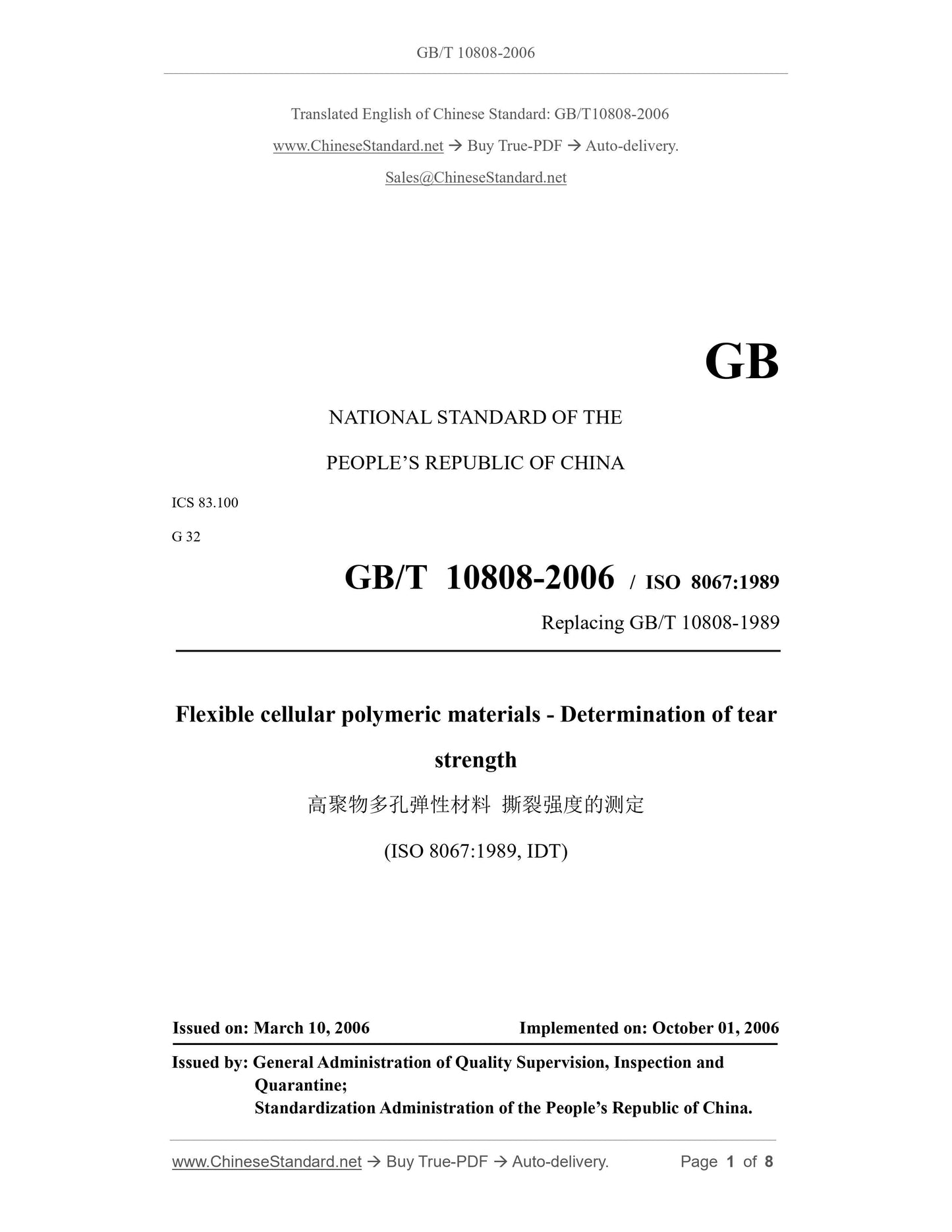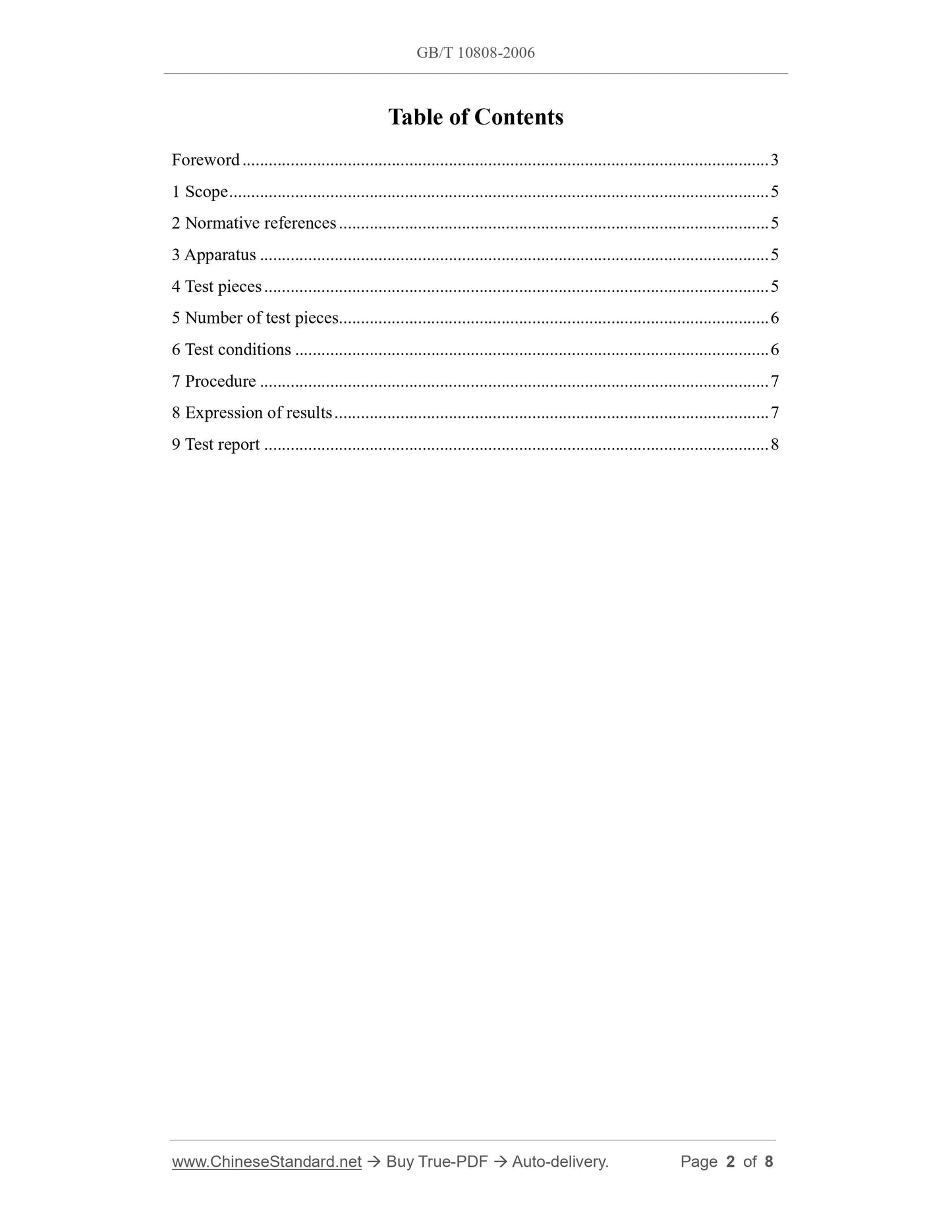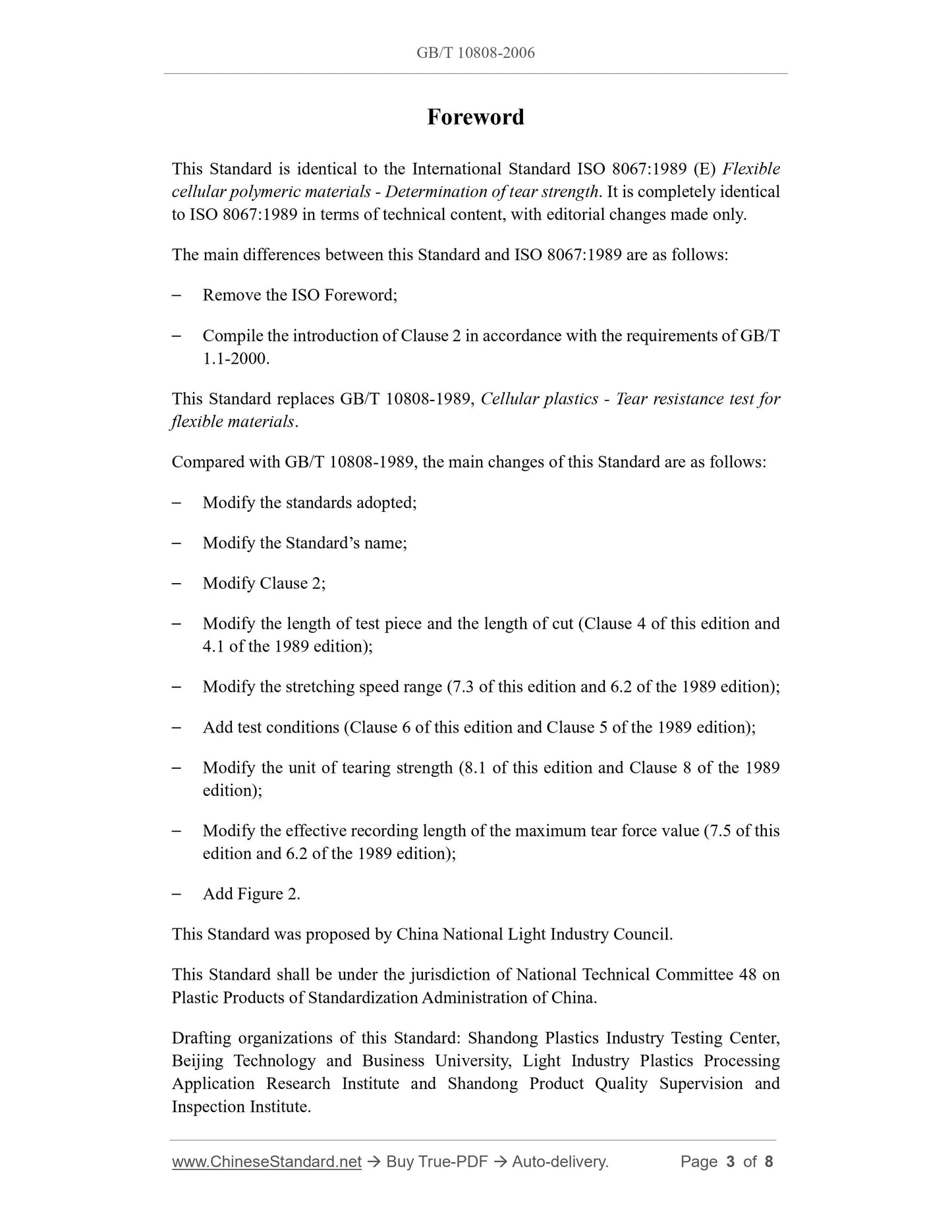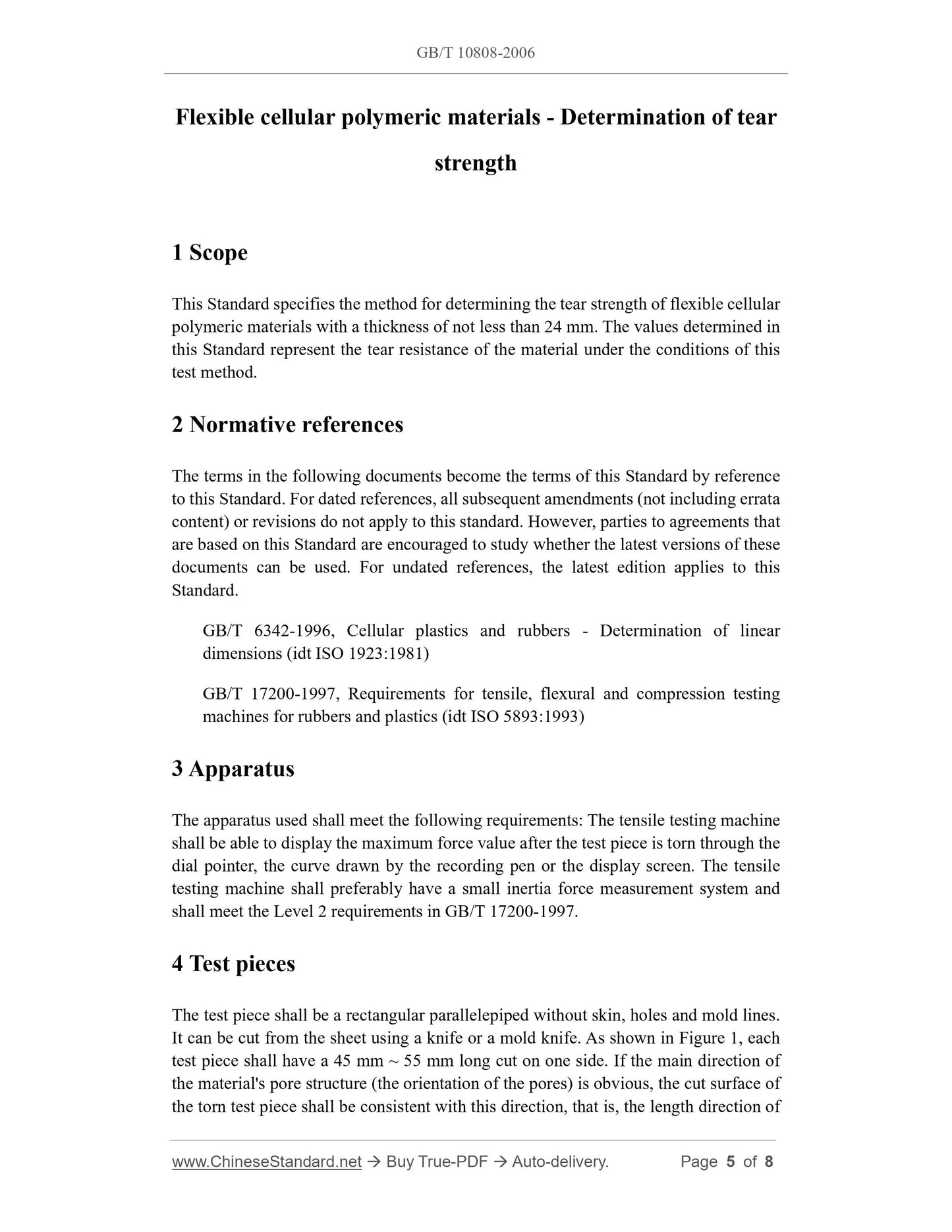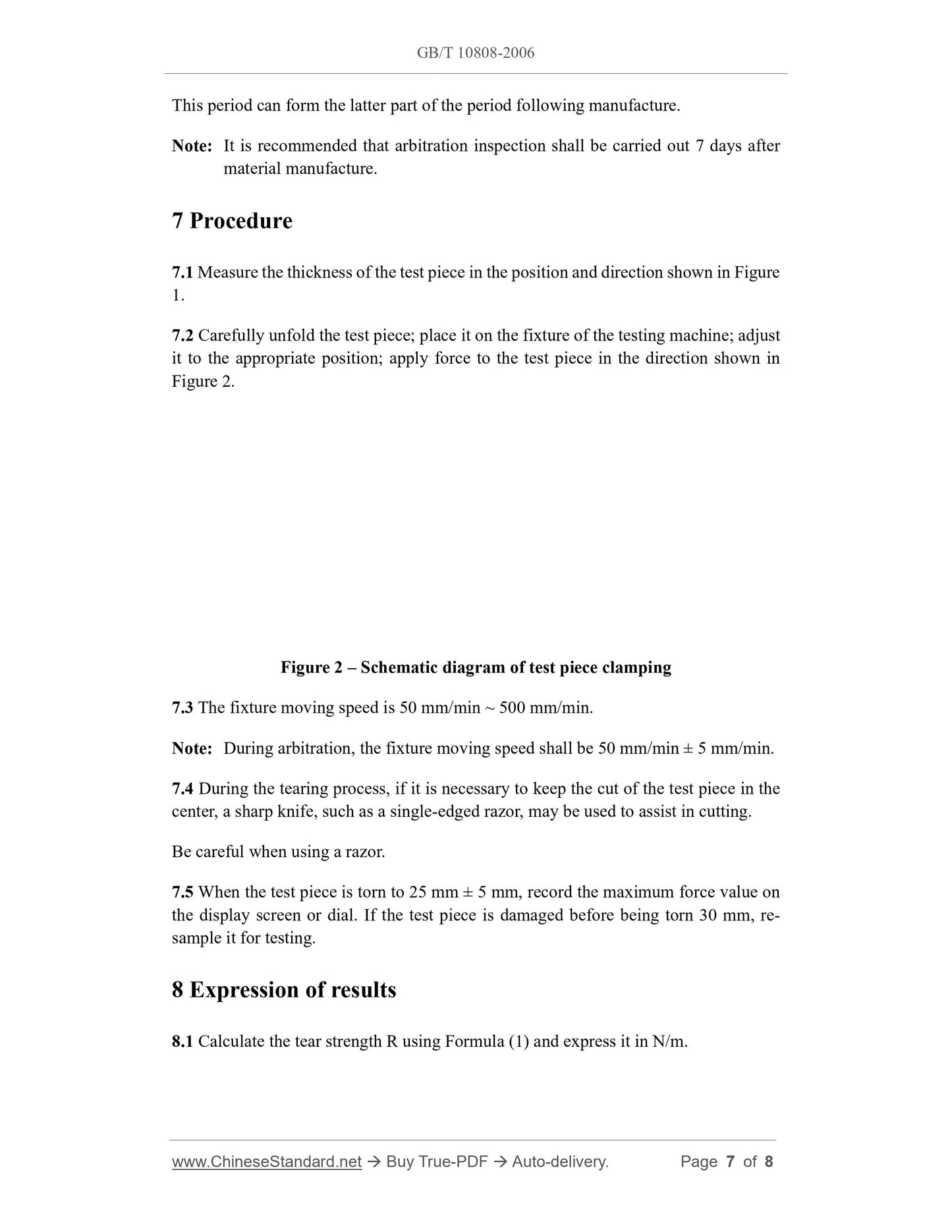1
/
of
5
PayPal, credit cards. Download editable-PDF and invoice in 1 second!
GB/T 10808-2006 English PDF (GBT10808-2006)
GB/T 10808-2006 English PDF (GBT10808-2006)
Regular price
$75.00 USD
Regular price
Sale price
$75.00 USD
Unit price
/
per
Shipping calculated at checkout.
Couldn't load pickup availability
Delivery: 3 seconds. Download true-PDF + Invoice.
Get QUOTATION in 1-minute: Click GB/T 10808-2006
Historical versions: GB/T 10808-2006
Preview True-PDF (Reload/Scroll if blank)
GB/T 10808-2006: Flexible cellular polymeric materials -- Determination of tear strength
GB/T 10808-2006
GB
NATIONAL STANDARD OF THE
PEOPLE’S REPUBLIC OF CHINA
ICS 83.100
G 32
GB/T 10808-2006 / ISO 8067:1989
Replacing GB/T 10808-1989
Flexible cellular polymeric materials - Determination of tear
strength
(ISO 8067:1989, IDT)
ISSUED ON: MARCH 10, 2006
IMPLEMENTED ON: OCTOBER 01, 2006
Issued by: General Administration of Quality Supervision, Inspection and
Quarantine;
Standardization Administration of the People’s Republic of China.
Table of Contents
Foreword ... 3
1 Scope ... 5
2 Normative references ... 5
3 Apparatus ... 5
4 Test pieces ... 5
5 Number of test pieces ... 6
6 Test conditions ... 6
7 Procedure ... 7
8 Expression of results ... 7
9 Test report ... 8
Foreword
This Standard is identical to the International Standard ISO 8067:1989 (E) Flexible
cellular polymeric materials - Determination of tear strength. It is completely identical
to ISO 8067:1989 in terms of technical content, with editorial changes made only.
The main differences between this Standard and ISO 8067:1989 are as follows:
⎯ Remove the ISO Foreword;
⎯ Compile the introduction of Clause 2 in accordance with the requirements of GB/T
1.1-2000.
This Standard replaces GB/T 10808-1989, Cellular plastics - Tear resistance test for
flexible materials.
Compared with GB/T 10808-1989, the main changes of this Standard are as follows:
⎯ Modify the standards adopted;
⎯ Modify the Standard’s name;
⎯ Modify Clause 2;
⎯ Modify the length of test piece and the length of cut (Clause 4 of this edition and
4.1 of the 1989 edition);
⎯ Modify the stretching speed range (7.3 of this edition and 6.2 of the 1989 edition);
⎯ Add test conditions (Clause 6 of this edition and Clause 5 of the 1989 edition);
⎯ Modify the unit of tearing strength (8.1 of this edition and Clause 8 of the 1989
edition);
⎯ Modify the effective recording length of the maximum tear force value (7.5 of this
edition and 6.2 of the 1989 edition);
⎯ Add Figure 2.
This Standard was proposed by China National Light Industry Council.
This Standard shall be under the jurisdiction of National Technical Committee 48 on
Plastic Products of Standardization Administration of China.
Drafting organizations of this Standard: Shandong Plastics Industry Testing Center,
Beijing Technology and Business University, Light Industry Plastics Processing
Application Research Institute and Shandong Product Quality Supervision and
Inspection Institute.
Flexible cellular polymeric materials - Determination of tear
strength
1 Scope
This Standard specifies the method for determining the tear strength of flexible cellular
polymeric materials with a thickness of not less than 24 mm. The values determined in
this Standard represent the tear resistance of the material under the conditions of this
test method.
2 Normative references
The terms in the following documents become the terms of this Standard by reference
to this Standard. For dated references, all subsequent amendments (not including errata
content) or revisions do not apply to this standard. However, parties to agreements that
are based on this Standard are encouraged to study whether the latest versions of these
documents can be used. For undated references, the latest edition applies to this
Standard.
GB/T 6342-1996, Cellular plastics and rubbers - Determination of linear
dimensions (idt ISO 1923:1981)
GB/T 17200-1997, Requirements for tensile, flexural and compression testing
machines for rubbers and plastics (idt ISO 5893:1993)
3 Apparatus
The apparatus used shall meet the following requirements: The tensile testing machine
shall be able to display the maximum force value after the test piece is torn through the
dial pointer, the curve drawn by the recording pen or the display screen. The tensile
testing machine shall preferably have a small inertia force measurement system and
shall meet the Level 2 requirements in GB/T 17200-1997.
4 Test pieces
The test piece shall be a rectangular parallelepiped without skin, holes and mold lines.
It can be cut from the sheet using a knife or a mold knife. As shown in Figure 1, each
test piece shall have a 45 mm ~ 55 mm long cut on one side. If the main direction of
the material's pore structure (the orientation of the pores) is obvious, the cut surface of
the torn test piece shall be consistent with this direction, that is, the length direction of
This period can form the latter part of the period following manufacture.
Note: It is recommended that arbitration inspection shall be carried out 7 days after
material manufacture.
7 Procedure
7.1 Measure the thickness of the test piece in the position and direction shown in Figure
1.
7.2 Carefully unfold the test piece; place it on the fixture of the testing machine; adjust
it to the appropriate position; apply force to the test piece in the direction shown in
Figure 2.
Figure 2 – Schematic diagram of test piece clamping
7.3 The fixture moving speed is 50 mm/min ~ 500 mm/min.
Note: During arbitration, the fixture moving speed shall be 50 mm/min ± 5 mm/min.
7.4 During the tearing process, if it is necessary to keep the cut of the test piece in the
center, a sharp knife, such as a single-edged razor, may be used to assist in cutting.
Be careful when using a razor.
7.5 When the test piece is torn to 25 mm ± 5 mm, record the maximum force value on
the display screen or dial. If the test piece is damaged before being torn 30 mm, re-
sample it for testing.
8 Expression of results
8.1 Calculate the tear strength R using Formula (1) and express it in N/m.
Get QUOTATION in 1-minute: Click GB/T 10808-2006
Historical versions: GB/T 10808-2006
Preview True-PDF (Reload/Scroll if blank)
GB/T 10808-2006: Flexible cellular polymeric materials -- Determination of tear strength
GB/T 10808-2006
GB
NATIONAL STANDARD OF THE
PEOPLE’S REPUBLIC OF CHINA
ICS 83.100
G 32
GB/T 10808-2006 / ISO 8067:1989
Replacing GB/T 10808-1989
Flexible cellular polymeric materials - Determination of tear
strength
(ISO 8067:1989, IDT)
ISSUED ON: MARCH 10, 2006
IMPLEMENTED ON: OCTOBER 01, 2006
Issued by: General Administration of Quality Supervision, Inspection and
Quarantine;
Standardization Administration of the People’s Republic of China.
Table of Contents
Foreword ... 3
1 Scope ... 5
2 Normative references ... 5
3 Apparatus ... 5
4 Test pieces ... 5
5 Number of test pieces ... 6
6 Test conditions ... 6
7 Procedure ... 7
8 Expression of results ... 7
9 Test report ... 8
Foreword
This Standard is identical to the International Standard ISO 8067:1989 (E) Flexible
cellular polymeric materials - Determination of tear strength. It is completely identical
to ISO 8067:1989 in terms of technical content, with editorial changes made only.
The main differences between this Standard and ISO 8067:1989 are as follows:
⎯ Remove the ISO Foreword;
⎯ Compile the introduction of Clause 2 in accordance with the requirements of GB/T
1.1-2000.
This Standard replaces GB/T 10808-1989, Cellular plastics - Tear resistance test for
flexible materials.
Compared with GB/T 10808-1989, the main changes of this Standard are as follows:
⎯ Modify the standards adopted;
⎯ Modify the Standard’s name;
⎯ Modify Clause 2;
⎯ Modify the length of test piece and the length of cut (Clause 4 of this edition and
4.1 of the 1989 edition);
⎯ Modify the stretching speed range (7.3 of this edition and 6.2 of the 1989 edition);
⎯ Add test conditions (Clause 6 of this edition and Clause 5 of the 1989 edition);
⎯ Modify the unit of tearing strength (8.1 of this edition and Clause 8 of the 1989
edition);
⎯ Modify the effective recording length of the maximum tear force value (7.5 of this
edition and 6.2 of the 1989 edition);
⎯ Add Figure 2.
This Standard was proposed by China National Light Industry Council.
This Standard shall be under the jurisdiction of National Technical Committee 48 on
Plastic Products of Standardization Administration of China.
Drafting organizations of this Standard: Shandong Plastics Industry Testing Center,
Beijing Technology and Business University, Light Industry Plastics Processing
Application Research Institute and Shandong Product Quality Supervision and
Inspection Institute.
Flexible cellular polymeric materials - Determination of tear
strength
1 Scope
This Standard specifies the method for determining the tear strength of flexible cellular
polymeric materials with a thickness of not less than 24 mm. The values determined in
this Standard represent the tear resistance of the material under the conditions of this
test method.
2 Normative references
The terms in the following documents become the terms of this Standard by reference
to this Standard. For dated references, all subsequent amendments (not including errata
content) or revisions do not apply to this standard. However, parties to agreements that
are based on this Standard are encouraged to study whether the latest versions of these
documents can be used. For undated references, the latest edition applies to this
Standard.
GB/T 6342-1996, Cellular plastics and rubbers - Determination of linear
dimensions (idt ISO 1923:1981)
GB/T 17200-1997, Requirements for tensile, flexural and compression testing
machines for rubbers and plastics (idt ISO 5893:1993)
3 Apparatus
The apparatus used shall meet the following requirements: The tensile testing machine
shall be able to display the maximum force value after the test piece is torn through the
dial pointer, the curve drawn by the recording pen or the display screen. The tensile
testing machine shall preferably have a small inertia force measurement system and
shall meet the Level 2 requirements in GB/T 17200-1997.
4 Test pieces
The test piece shall be a rectangular parallelepiped without skin, holes and mold lines.
It can be cut from the sheet using a knife or a mold knife. As shown in Figure 1, each
test piece shall have a 45 mm ~ 55 mm long cut on one side. If the main direction of
the material's pore structure (the orientation of the pores) is obvious, the cut surface of
the torn test piece shall be consistent with this direction, that is, the length direction of
This period can form the latter part of the period following manufacture.
Note: It is recommended that arbitration inspection shall be carried out 7 days after
material manufacture.
7 Procedure
7.1 Measure the thickness of the test piece in the position and direction shown in Figure
1.
7.2 Carefully unfold the test piece; place it on the fixture of the testing machine; adjust
it to the appropriate position; apply force to the test piece in the direction shown in
Figure 2.
Figure 2 – Schematic diagram of test piece clamping
7.3 The fixture moving speed is 50 mm/min ~ 500 mm/min.
Note: During arbitration, the fixture moving speed shall be 50 mm/min ± 5 mm/min.
7.4 During the tearing process, if it is necessary to keep the cut of the test piece in the
center, a sharp knife, such as a single-edged razor, may be used to assist in cutting.
Be careful when using a razor.
7.5 When the test piece is torn to 25 mm ± 5 mm, record the maximum force value on
the display screen or dial. If the test piece is damaged before being torn 30 mm, re-
sample it for testing.
8 Expression of results
8.1 Calculate the tear strength R using Formula (1) and express it in N/m.
Share
